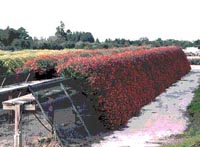Resource Library
Plant of the Week: Weeping Chrysanthemum
The University of Arkansas System Division of Agriculture does not promote, support or recommend plants featured in "Plant of the Week." Please consult your local Extension office for plants suitable for your region.
Weeping Chrysanthemum
Latin: Dendranthema grandiflora

Weeping plant forms have always intrigued me, partly because of their graceful curves
and partly because of an interest in the odd and unusual.
In my college days, I ran across an advertisement for a weeping chrysanthemum, a plant
I only knew as a righteously upright grower. So, forgetting the advice my mother taught
me about things being too good to be true, I dutifully sent in my $5 to check it out.
By return mail, I received a chrysanthemum cutting, a coat hanger and a crudely drawn
illustration explaining how to train the plant to make it grow against the forces
of nature. Gardeners should hold onto their money. I’ll share the secret for free.
Weeping chrysanthemums are often used as a part of flower show displays and in public
display gardens. The effect can be spectacular with individual plants having hundreds
of flowers. To achieve the truly spectacular size attained in some of the display
gardens plants must be grown about nine months to achieve the desired effect. By comparison,
the chrysanthemums we see in the stores each fall are about three-months old.
Chrysanthemums are classic short-day plants with blooming controlled by the relative
length of the day and night. When the night gets longer than nine hours, chrysanthemums
begin to set flower buds. In Arkansas, this usually occurs about mid August with blooms
appearing about eight weeks later.
The bushel basket size garden mums we see in the stores were simply started earlier
in the summer and allowed to grow longer before short-day conditions arrived and triggered
flowering. The little plants in 6-inch pots were planted about July 1 and only allowed
to grow a few weeks before the arrival of short days stopped their vegetative growth
and triggered the formation of buds.
Weeping chrysanthemums are started in January and grown in a greenhouse under long-day
conditions. To keep the plants from setting flower buds, lights are set to come on
every night above the plants from 10 p.m. until 2 a.m. This breaks up the night into
two segments, each shorter than the nine hours required to trigger flowering. The
plants are grown in nursery pots with a tall, unpinched stem affixed to a bamboo pole.
By the time spring arrives - and the night lighting no longer needed - the plants
will be 3 to 4 feet tall and straight as a telephone pole.
At this point, the plants can be moved outside. A Florida grower, who specializes
in weeping chrysanthemums, has a series of chain-link fences built at 30-degree angles
with a shelf at the top to hold the pot. Once the tall, spindly plants are moved outside
and the stake removed, the plants topple over. The length of the stem at the time
the stake is removed determines how long the weeping plant will be. Now, with the
plant stem upside down, there is no hormonal control from the terminal bud and all
of the side buds begin growing, just as a tree will send up side shoots if it falls
in the forest.
These side shoots - all of which now grow up, not down - are then pinched and pruned
as needed to achieve the desired shape and form for the plant. All pruning and pinching
is discontinued after late July because the plants will soon be setting flower buds
as short days of autumn arrive. While these cascading beauties have little place in
the average suburban garden, it’s always fun to be let in on the secret of how these
horticultural novelties are produced.
By: Gerald Klingaman, retired
Extension Horticulturist - Ornamentals
Extension News - November 3, 2000
The University of Arkansas System Division of Agriculture does not maintain lists of retail outlets where these plants can be purchased. Please check your local nursery or other retail outlets to ask about the availability of these plants for your growing area.